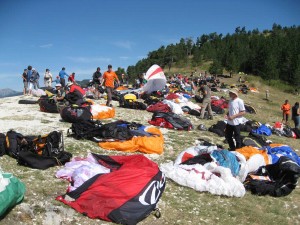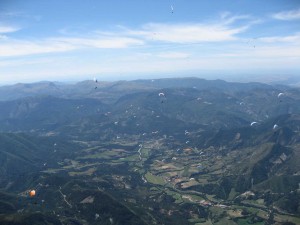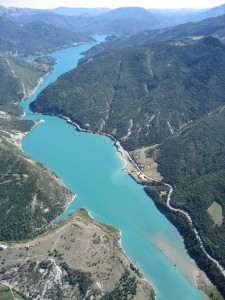I was in St Andre des Alpes in France last week competing in the British Paragliding Open. There were 150 international competitors, making the event completely full. This location is often described as ‘one of the best places in the world to hold a paragliding competition’ and it’s easy to see why. The weather, certainly in late August, early September is so reliable and the thermic strengths are somewhere between good and F good! The surrounding area has a variety of ridges and valleys, with some huge mountains like the Cheval Blanc thrown in for good measure. These two elements combine to produce tasks that are both interesting and often challenging.

Busy take off at St Andre
I had wrestled with the decision to stick with the Triton X for this comp, having been properly beaten by the ‘R10 squadron’ at my previous 2 cat2 comps. I had thought that with the usual rough air encountered at this location, the solid Triton X would hold a slight advantage (similar to the serial / comp wing advantage in really rough air), but I was surprised how well the new 2-liners perform in the rough stuff – until they go of course, then all hell breaks loose :)
The first task on the Sunday was a 62.2km race to goal, during which I had a fantastic race up at the sharp end. At the last turnpoint, I turned in 8th position with the lead gaggle of R10s for the 4 km run into goal. As we got closer to the goal, the winds at the lower level were very strong and I started to get worried as the R10s cut through the breeze much better than I did, but was still confident we would find enough lift to get to the 400m cylinder. At the point that I was too far from the ridge to go back and top up, I knew that a safe landing was my new goal. Standing with a couple of R10 pilots that had made the same error, I had to pack up 930m from the goal whilst watching another 80 or so pilots cruise in overhead. The first time I had landed just short! As it turned out the task was cancelled shortly after I landed, due to the strengthening wind around the goal area. So the task was scored back 10 minutes, which meant I wasn’t punished quite so hard for my error.
Monday was cancelled due to strong winds, so a group of us went walking in the fabulous Verdon Gorge, a 25km long slot that has 700m vertical sides and incredible views.

Verdon Gorge
On Tuesday, an 82km task to the North of the area went well for me at first flying with the first gaggle. As the turnpoint was 2 or 3 km in the lee of a huge ridge, I continued to push with the leaders, knowing that there was a fallback ridge to the east that would be into wind. Again, as we turned around, the wind meant that you were only getting back over the ridge if you were in orbit. The field quickly split and I spend 30 mins trying to soar up the fallback ridge. Once I got up, the thermals were topping out at just over 3200m, which gave an incredible view from the Northern Alps to the Mediterranean coast. I made it into goal, but over 45 mins behind the winner.
On Wednesday an 88km task with a turnpoint part way down the famous Dormillouse ridge. Once again, I was with the lead gaggle until one ridge before the turnpoint, a hasty decision to leap forward cost me 5 mins of trying to find lift whilst the majority flew overhead having topped up. This gap then opened as we flew back into wind, so I took the safer but slower route back to goal. During the day 5 reserves were thrown, but most of the pilots involved acknowledged that they were probably to blame for being in the wrong place at the wrong time!

Waiting for the start
For Thursday, a 68.4km task sorted the field, as part way around cirrus clouds killed the lift for a while, meaning unless you were high at that point the ground was probably going to win. I was guilty of a risky low route after the penultimate turnpoint which ended with a 20 min fight to avoid going down. I eventually landed in a cluster of pilots who had made the same error.
On Friday 86.4km, another tricky day put most of the lead gaggle on the deck. I made a terrible start and had to risk a low valley crossing to get back in the mix. A 20 min delay to soar up a ridge at the end of a valley saw me slip back through the field. Once at height, I was able to make up lots of ground, only to get too racy and get stuck again in the lee of a huge ridge. I eventually climbed back up and was relieved to complete the course, with many of the lead pilots coming back on the retrieve bus.
The last day of the competition started with a windy gliding forecast and an ambitious 76.6km set to avoid the windy areas. The thermals broken by the wind were as rough as they had been all week, with the Triton X trying to do its best break-dancing routine above me. As it happened, the task was stopped, as it became obvious that the increasing wind would punish the field. I managed to fly back to the goal, but on route I definitely thought that it was the right decision to stop it.
Overall, another great British comp in a stunning location, with the organisation focussing very much on the safety of the pilots. My own performance was much less than I had hoped for, but you have to remember it’s only a game !

High over the lake at St Andre
